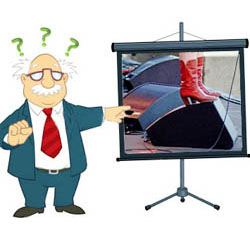
20 Questions Quiz, 5-8 Below
5. What is the proper amount of amplification applied to a monitor?
A. 100 percent of wedge/raw frame recommendation from the manufacturer
B. 95 percent of wedge/raw frame recommendation from the manufacturer
C. 300 percent of wedge/raw frame recommendation from the manufacturer
D. Mono anything you can get your hands on, dump it on the paper, and use whatever is left for the titanium
.
6. Is a 2-inch high-frequency (HF) driver better than a 1-inch?
A. 2 is always better than 1—everyone knows that
B. No – most 2-inch drivers have less HF extension and weird midrange anomalies that sully vocal quality
C. Yes – the weird midrange anomalies of 2-inch drivers tie in nicely with the “bark” at 1.25 kHz needed for vocal breakthrough
D. It depends. Older alnico 2-inch drivers need a tweeter to get adequate HF extension, whereas newer rare earth 2-inch drivers don’t need a tweeter yet lack a certain “snap” and depth associated with alnico drivers. None of these issues come up with 1-inch drivers
.
7. Should monitors be ported or sealed?
A. Sealed—the measured response is flatter and there is no port noise to interfere with real sound
B. Ported—more SPL can be produced with any audible problems caused by the ports fixed with equalization
C. Ported only if there are rectangular ports loading the floor, thereby achieving a quasi-folded horn affect for LF data in the mix, such as kick
D. It depends. Monitors should be designed with ports and fashion seals that can be inserted into the ports in situations of lower volume or no/low drums, where the ports are not as necessary to achieve desired outcome
.
8. What about feedback loop/black box monitor systems?
A. Forget it—they sound dated, are overpriced, and their shifting crossover points and side-chain EQ bothers many artists
B. They’re best for anything but metal music, requiring the least EQ and possessing well thought-out level-related response patterns
C. It depends. The ferrofluid in the gap can caramelize, and the voice coils can lock up when hit hard, but in medium level use, they have the best combination of ease of use and user acceptance
D. It depends on the vintage of the system. Ask experienced users of the equipment in question and they will direct you toward the particular models that have the best raw frame, as manufacturers of these products sometimes change things. These changes are more evident in a black box system than in systems with direct user control of all crossover parameters


